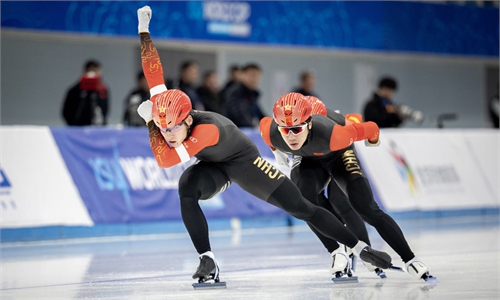ARTS / CULTURE & LEISURE
Red-hot ice-snow trips heat up winter

Illustration: Liu Xiangya/Global Times
The 2023 Skiing Trip Trend Report, recently released by an online travel platform, shows that the popularity of skiing-related searches increased by 120 percent in the first week of November. The booking volume of skiing tickets and related products rose by more than 100 percent monthly. Hotel reservations in Zhangjiakou, Hebei Province, where the skiing events of the Beijing Winter Olympics were held, have skyrocketed nearly 10 times year-on-year. According to data from a leading e-commerce platform for services, from November 1 to 9, the revenue of group buying skiing tickets grew by 209 pecent compared to the same period in 2019.
The China Tourism Academy estimates in its 2023 China Ice-snow Tourism Development Report that the number of tourists in China will still exceed 300 million during the snow season from 2023 to 2024 and is expected to reach 520 million from 2024 to 2025 with a total income of 720 billion yuan ($101 billion).
The industry predicts that the 2023-24 snow season will substantially promote the recovery of the domestic ski market. From research by an online travel platform academy, in addition to first and second-tier cities, more tourists from third- and fourth-tier cities have also joined ski groups. Besides this, the average age of these tourists has become younger, with Post-1990 and Post-2000 generations becoming the primary consumers and their proportion of bookings up 60 percent. Why has ice-snow tourism gained steam recently, with travelers multiplying and more younger people taking part?
Economically, China's per capita GDP reached $11,300 in 2020. Studies indicate that the sports industry grows significantly when a country's per capita GDP exceeds $8,000, while the ice and snow industry tends to flourish when it is over $10,000. China has ushered in a golden era for the prosperity of winter sports.
Thanks to the Beijing 2022 Olympic Winter Games, the ice-snow economy has developed into an engine driving China's tourism and sports industry. Winter tourism, equipment manufacturing, professional training, and venue construction and operation have advanced dramatically in recent years, resulting in a more complete industrial chain.
Accordingly, winter tourism products are becoming more abundant with cost-effective choices, and a larger crowd of people have access to ice-snow activities. Thus, many people, especially the young, can afford such activities. They also split the accommodation, transportation and equipment bills to bring down expenses. This practice has gradually become prevalent, and youngsters enjoy sharing their experiences on social media platforms, thus increasing peer participation.
Besides this, the preference for skiing among the young generation stems from the following reasons. To begin with, skiing relieves stress. A survey jointly conducted by an industry data analysis platform and an advertising media company shows that white-collar workers, particularly internet employees, account for 72.4 percent of skiers. They are usually under tremendous pressure and seek ways to alleviate it.
As skiers, they can enjoy immersive experiences that focus on physical activities and allow them to get away from daily work and trivial things to enjoy a release of dopamine. Then, they can interact and build friendships to meet their social needs.
Moreover, they can gain a sense of achievement by reaching a new level of skiing prowess and going beyond their limits repeatedly, empowering and encouraging them to progress even further. Even people who are socially awkward can find a way to get along well with themselves. Unlike team activities such as "murder mystery games," escape prison games, and camping, in which you need to take part in a group, skiing possesses more facades, creates richer experiences, and has more possibilities through concentrating and facing challenges. Also, the outstanding performance of young sports stars makes them idols and attracts more attention from peer groups.
The most significant legacy of the Beijing Winter Olympics has been the successful efforts to engage more than 300 million people in China in snow and ice activities. This has expanded participation from certain local hotspots to nationwide, from winter to all four seasons, and shifted ice-snow activities like skiing from a niche sport to a popular daily routine.
How can we keep this momentum up and go further?
For one thing, we should continuously expand the supply of high-quality ice-snow tourism products by integrating various cultural elements into tourism projects such as skiing, mountaineering, hiking, and ice carving, organizing activities and building brand events to reach and attract broader demographics.
The success of Cunchao, or the Village Super Football League, in Southwest China's Guizhou Province, is a signature example of this path in culture and tourism. For another, we should keep upgrading ice-snow tourism infrastructure and services to create an industry that can meet the potential demand of consumers.
The tourism industry has become an essential pillar for meeting the people's needs for a better life and promoting high-quality development. Constant exploration into the industry chain featuring cultural, tourism, and sports integration will boost the economy and improve people's lives.
The author is a faculty member with the School of Applied Economics, Renmin University of China. life@globaltimes.com.cn

